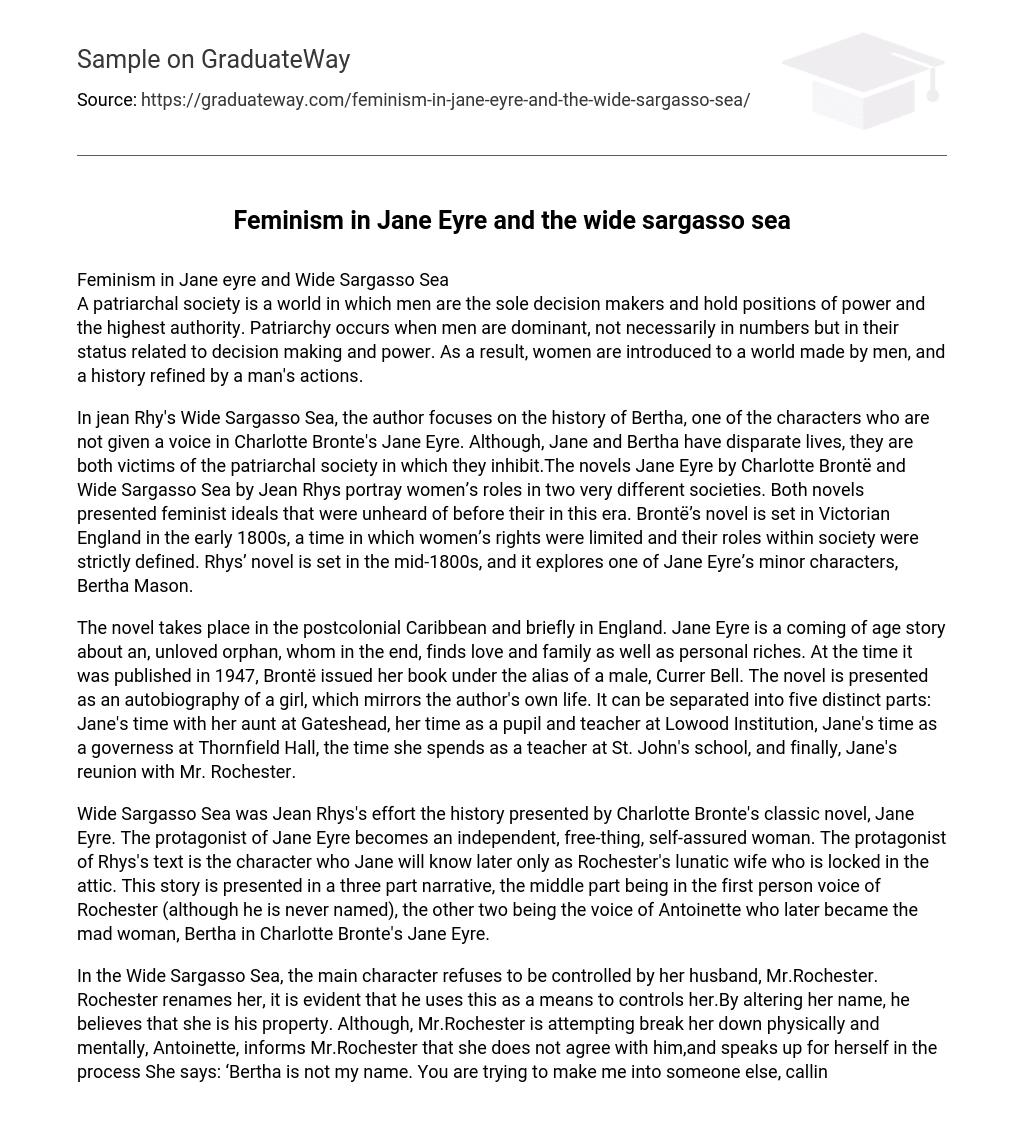Feminism is a theme explored in both Jane Eyre and Wide Sargasso Sea. In these novels, a patriarchal society is depicted as a world where men have exclusive decision-making power and hold positions of authority. Men establish dominance not necessarily through their numbers, but through their control over decision-making and positions of power. Consequently, women are introduced to a world shaped by men and a history refined by male actions.
The exploration of Bertha’s history, a character in Charlotte Bronte’s Jane Eyre, is depicted in Jean Rhys’ Wide Sargasso Sea. Despite their divergent lives, both Jane and Bertha fall victim to the patriarchal society they reside in. The novels Jane Eyre and Wide Sargasso Sea present the roles of women in two contrasting societies while introducing feminist ideals previously unheard of. Taking place during the early 1800s in Victorian England, Jane Eyre portrays an era when women faced restrictions on their rights and were confined to specific societal roles. In contrast, Wide Sargasso Sea is set during the mid-1800s and delves into Bertha Mason’s narrative as a secondary character from Jane Eyre.
The novel is set in the postcolonial Caribbean and briefly in England. Jane Eyre is a coming of age story about an orphan who is unloved, but eventually finds love, family, and personal riches. When it was published in 1947, Brontë used the pseudonym Currer Bell. The novel is presented as an autobiography that reflects the author’s own life. It can be divided into five main parts: Jane’s time with her aunt at Gateshead, her experiences as a pupil and teacher at Lowood Institution, her position as a governess at Thornfield Hall, her time as a teacher at St. John’s school, and finally, her reunion with Mr. Rochester.
Jean Rhys’s Wide Sargasso Sea is a reimagining of the story portrayed in Charlotte Bronte’s Jane Eyre. In Jane Eyre, the main character evolves into an independent and confident woman. However, in Rhys’s text, the focus shifts to the character who is later known as Rochester’s deranged wife, confined to the attic. The narrative is divided into three parts; the middle part is narrated in first person by Rochester (although he remains unnamed), while the other two parts are told from the perspective of Antoinette, who ultimately becomes the mad woman referred to as Bertha in Jane Eyre.
The protagonist of the Wide Sargasso Sea refuses to be controlled by her husband, Mr. Rochester. It is clear that Rochester asserts dominance over her by renaming her, using this as a means of exerting control. By changing her name, he sees her as his possession. Despite Mr. Rochester’s attempts to break her physically and mentally, Antoinette states to him that she disagrees and stands up for herself in the process. She states: ‘Bertha is not my name. You are trying to alter my identity, referring to me with a different name’ (Rhys 115).
One way in which Rochester asserts his masculine power over his wife is by changing her name, but Antoinette appears to only agree to it. However, she refuses to be controlled by a man and stands up to Mr. Rochester. Ultimately, she manages to escape the abuse inflicted by Mr. Rochester by making her final act of self-determination – setting his home on fire. This act depicts female liberation.
Antoinette acknowledges her unavoidable destiny and assumes authority over her own fate. Despite the presence of a male-dominated society in Jane Eyre, she resolutely rejects the notion of being inferior due to her personality, actions, thoughts, and beliefs. From the beginning of the novel, Jane’s formidable character is apparent as she frequently debates men regarding women’s societal roles.
In addition to this, her rejection of societal cultural standards can be seen throughout the entirety of the novel. This is exemplified by her response to Mr. Rochester’s efforts to shower her with extravagant jewelry and costly clothing for their wedding. She goes so far as to express that “the more he purchased for me, the more I felt a burning sensation of irritation and humiliation” (Bronte 623).
Her refusal to be objectified serves as a clear indicator that her beauty does not define her. The protagonist consistently demonstrates her disdain for male authority throughout her early years. In Gateshead Hall, Jane endures continuous mistreatment from her aunt, Ms. Reed, and her cousins, John, Eliza, and Georgiana. John, in particular, subjects Jane to isolation and fear, often physically assaulting her due to his belief that she is inferior as a woman and an orphan. When confronted with John’s attempts to mentally and physically harm her, Jane exclaims, “You are wicked and cruel! You are like a murderer – you are like a Roman emperor” (Bronte 65). Determined to put an end to the maltreatment by “the wicked boy,” Jane resolves to take firm action.
Jane’s response to John’s cruelty shows her determination to resist injustice, which is the first time she has stood up and fought back. Even though she may face punishment for her actions, she remains resolute in her decision to confront John. Her resistance against patriarchal obedience can be seen in her quarrel and struggle against John’s oppressive beliefs. Both Jane Eyre and Wide Sargasso Sea are powerful examples of feminist literature, despite their different backgrounds. Both characters acknowledge the existence of injustice in society. Through defying gender barriers, Jane Eyre presents a fearless woman who fights against gender inequality, striving for equal opportunities and fairness in society. She is an independent force guided by her own values and morals.
Contrary to the societal expectations imposed on women during the 19th century, Charlotte Bronte’s Jane Eyre stands as a defiant figure who defies conformity. This novel serves as a significant feminist testament and showcases Jane Eyre as an embodiment of the feminist movement. Through her character, Bronte portrays the pursuit of equality in various aspects such as social, sexual, political, intellectual, and economic rights for both genders.





